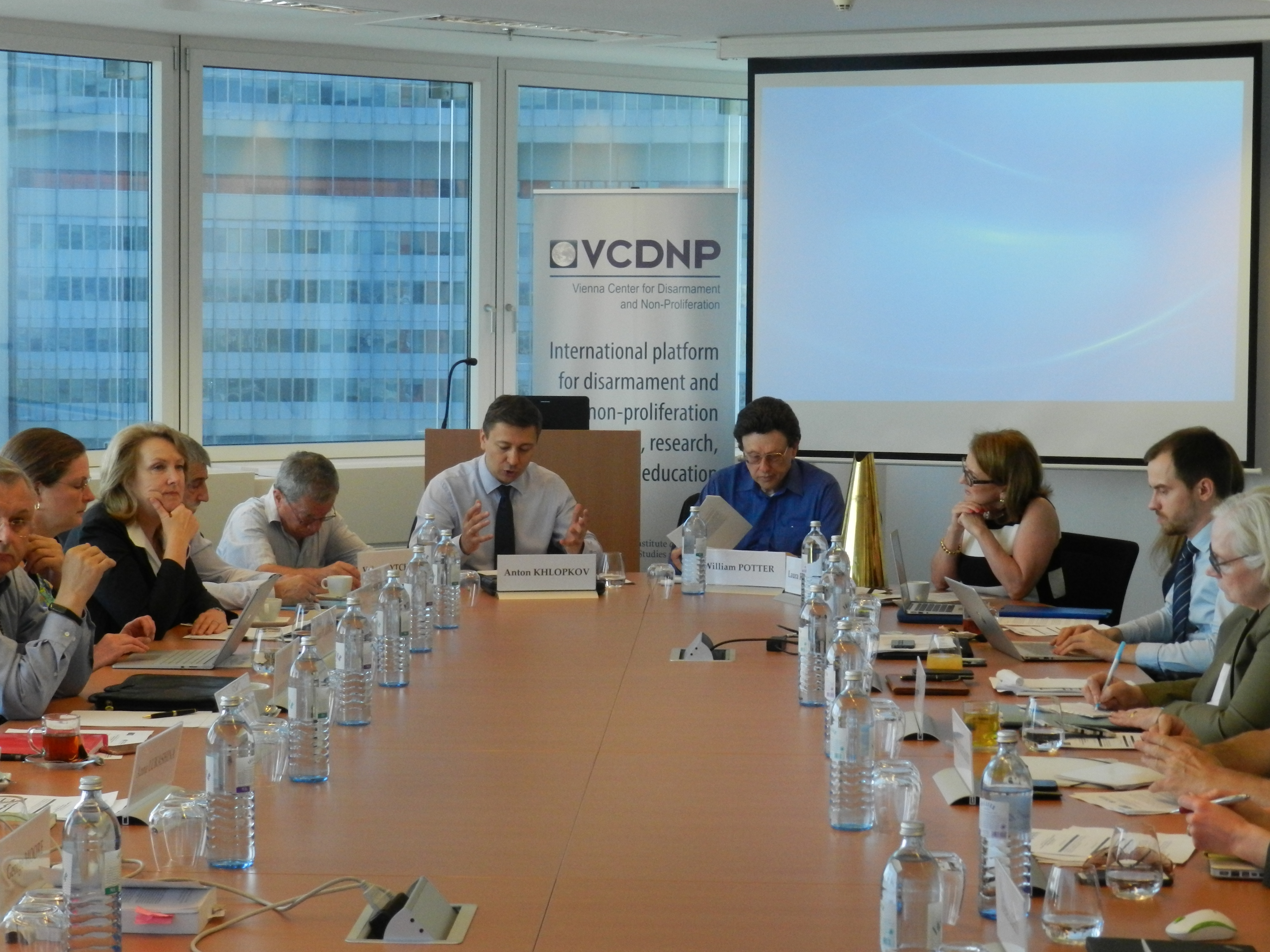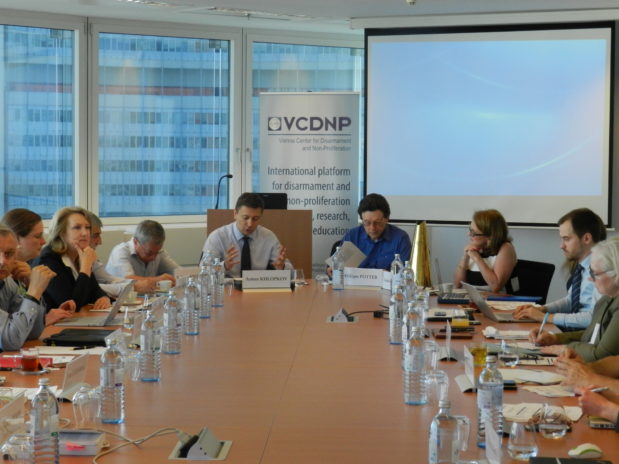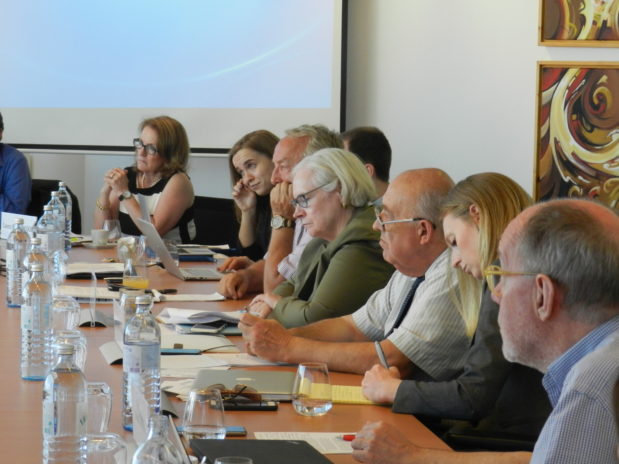
On 24 June 2017, the James Martin Center for Nonproliferation Studies (CNS) and the Center for Energy and Security Studies (CENESS) convened a US-Russia Dialogue on Nuclear Issues in Vienna, Austria. Current and former government officials, representatives from international organizations, and non-governmental (NGO) experts from both countries participated in this Track 1.5 event, hosted by the Vienna Center for Disarmament and Non-Proliferation Studies. The discussions benefited significantly from the participation of former US and Russian ambassadors to the international organizations in Vienna and Geneva.

The dialogue promoted discussion on a wide range of issues, including the Comprehensive Nuclear-Test-Ban Treaty, International Atomic Energy Agency (IAEA) safeguards, export controls, and the UN Conference on Disarmament. The four sessions that comprised the workshop featured both Russian and American speakers, followed by discussion.
The primary purpose of the workshop was to identify areas where and modalities by which the United States and Russia could cooperate more fruitfully to strengthen the international nonproliferation regime. The expert participants were well-equipped for the task, each with extensive experience in the field during both good and bad moments in the bilateral US-Russia relationship. The political context of the meeting was indeed challenging, even though issues of nuclear nonproliferation traditionally enjoy a significant level of cooperation between the two countries, including during some of the most difficult moments of the Cold War. Today, this cooperation, even on more technical and scientific issues, is no longer guaranteed. As one participant noted, in a climate where simply talking with Russian officials is considered suspect in the United States, there appears to be little room for cooperation. Given the role played by the United States and Russia in the international nuclear order, the cessation of dialogue in this area may have unpredictable consequences.
It was therefore welcome that, as the meeting proceeded, participants were able to identify a number of opportunities for US-Russian dialogue and cooperation, including through engagement at international organizations such as the IAEA. For example, during a session on technical cooperation, nuclear safety, and nuclear security, several promising ideas were broached that appeared to serve both Russian and American interests. These included possible cooperation in promoting radioisotope production using low-enriched uranium rather than highly enriched uranium. Participants highlighted convergent US and Russian interests as nuclear exporters in enhancing the safety and security of relevant infrastructure in recipient countries as well. Cooperation with third parties can also evolve in the following areas: contributing to safe and secure management of spent fuel and radioactive waste; transporting, storing, and disposing nuclear materials; recovering and safely disposing orphan radioactive sources; sharing best practices; and coordinating educational and training programs. Also relevant is the US-Russia-IAEA format of cooperation illustrated by the Russian Research Reactor Fuel Return Program.
In this same vein, participants explored how shared threat perceptions could encourage the two countries to cooperate. For example, they highlighted rising concerns in both Russia and the United States over radiological terrorism and convergent interests in creating joint centers for storing radiological sources in third countries, as well as cooperating on building and strengthening “second line of defense” infrastructure. Dialogue participants also suggested that cooperating in promoting linear accelerators for cancer treatment to replace cobalt-60 radiotherapy machines where feasible and economically viable and removing high-level radiological sources would enhance national and global security. In the context of the threat of WMD terrorism more broadly, one participant proposed that it would serve both countries’ interests for the United States and Russia to conduct joint studies of chemical and biological terrorism from a technical perspective. In doing so, one could more efficiently deal with WMD threats confronting both countries and on which both parties are already expending considerable resources. This collaboration also would have the additional benefit of enabling re-engagement on nonproliferation issues at the level of practitioners and technical experts.
However, both Russian and American participants noted several drawbacks that might potentially affect such cooperation within the IAEA. To begin with, the extrabudgetary nature of the Agency’s Technical Cooperation Fund impedes joint work in this domain. It was noted that a similar obstacle could frustrate cooperation on nuclear fuel cycle technology in the context of the International Project on Innovative Nuclear Reactors and Fuel Cycles. In light of this challenge, one participant suggested that visual aids could be helpful in making the case to domestic political audiences regarding the value of investing in technical cooperation. On the one hand, collaboration to ensure reliable and sustained funding for IAEA projects could have the added benefit of reviving and reinvigorating US-Russian technical cooperation for nonproliferation. One should be mindful, however, of the principle to “do no harm”: It is vitally important not to upset existing initiatives, where the United States and Russia still sustain a high level of cooperation.

Another Vienna-based international organization where the United States and Russia have cooperated fruitfully in the past is the Preparatory Commission for the Comprehensive Nuclear-Test-Ban Treaty Organization (CTBTO). Notwithstanding the United States’s failure to yet ratify the CTBT, workshop participants agreed that it would be desirable for the United States and Russia to cooperate in reinforcing the norm against nuclear testing by ensuring that the CTBTO is able to perform its mission. It is especially important not to lose sight of the centrality of the CTBT in the nonproliferation regime in light of the new Treaty on the Prohibition of Nuclear Weapons (TPNW). One promising area of cooperation concerns technical issues in support of the CTBTO’s international monitoring systems, for example, overcoming obstacles to the detection of radionuclides.
However, prospects are less encouraging in the sphere of disarmament. Despite the key role of the Conference on Disarmament (CD) in negotiating several nonproliferation and disarmament treaties, the future of the CD remains unclear, and there is no convergence of views about how to address various challenges, such as disarmament verification, WMD terrorism, negotiating a fissile material cut-off treaty, or the proposed Treaty on the Prevention of Placement of Weapons in Outer Space Treaty.
Both US and Russian experts expressed considerable interest, however, in the proposal to revisit the past joint draft Treaty on the Prohibition of Radiological Weapons, which they had tabledin the second half of the 1970s. In the absence of other clear opportunities for cooperation to resolve the deadlock in the CD, participants noted that the joint draft treaty might address a gap in the current the nonproliferation regime, and could be a useful tactical means by which a number of nuclear-weapon states (and perhaps the P-5 as a whole) demonstrated their commitment to promoting concrete disarmament measures at a time when they have been on the defensive due to the TPNW negotiations and in the lead up to the next preparatory committee meeting of the Treaty on the Non-Proliferation of Nuclear Weapons.
In some respect, the US-Russia Dialogue on Nuclear Issues confirmed what those in the field have long known to be true: it is much easier to bemoan the lack of US-Russian collaboration on nonproliferation than to identify practical means to revive cooperation. By acknowledging current realities and focusing on concrete measures, however, Dialogue participants succeeded in identifying some areas in and modes by which nonproliferation collaboration would appear to serve the interests of both countries. The starting point for this effort was an appreciation of both the contemporary situation and the historical record—too often forgotten—of US-Soviet cooperation for nonproliferation during the height of the Cold War. While the June workshop made a modest but real contribution to identifying concrete steps that need to be taken, it also was apparent to all workshop participants that further discussions and exchanges of ideas involving both government practitioners and nongovernmental experts were necessary. Participants also praised the work that has been done within the NGO community to keep these discussions alive. For instance, a joint report of CENESS and the Nuclear Threat Initiative, “Pathways of Cooperation” released earlier this year, was referred to during the workshop as a viable menu from which the United States and Russia could “select” projects for cooperation.
Indeed, both US and Russian participants appreciated that the process of discussion and exchange of views was as important as the specific ideas that were raised. Bearing this in mind, the organizers of the Dialogue are already working to plan the next workshop, which is scheduled for October 2017 in Moscow.